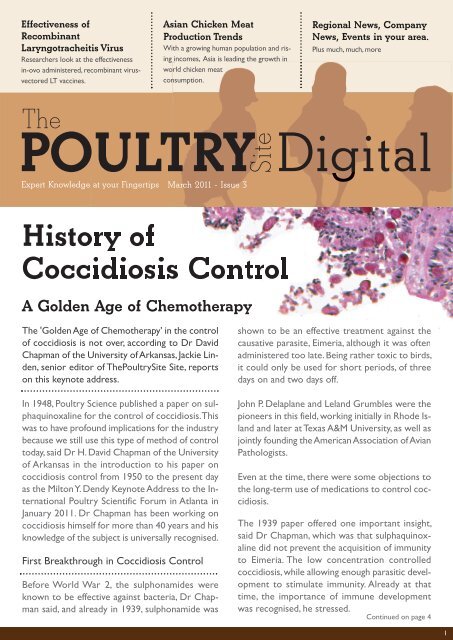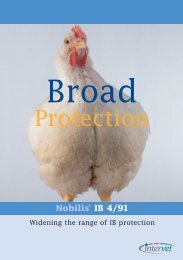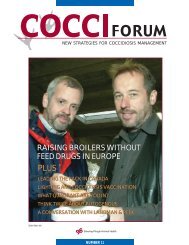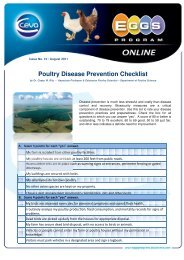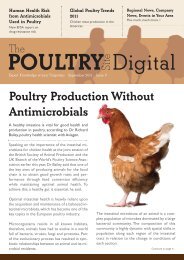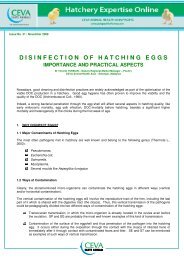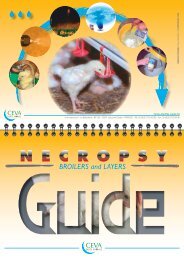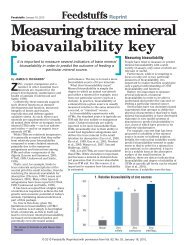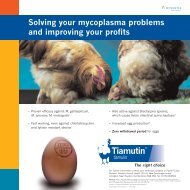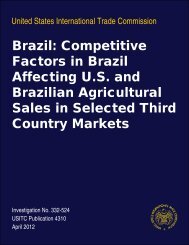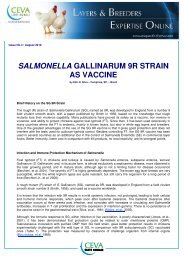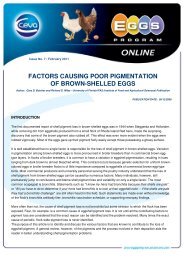Poultry_Digital_3_Layout 1 - The Poultry Site
Poultry_Digital_3_Layout 1 - The Poultry Site
Poultry_Digital_3_Layout 1 - The Poultry Site
Create successful ePaper yourself
Turn your PDF publications into a flip-book with our unique Google optimized e-Paper software.
Effectiveness ofRecombinantLaryngotracheitis VirusResearchers look at the effectivenessin-ovo administered, recombinant virusvectoredLT vaccines.Asian Chicken MeatProduction TrendsWith a growing human population and risingincomes, Asia is leading the growth inworld chicken meatconsumption.Regional News, CompanyNews, Events in your area.Plus much, much, more<strong>The</strong>POULTRY <strong>Digital</strong><strong>Site</strong>Expert Knowledge at your FingertipsMarch 2011 - Issue 3History ofCoccidiosis ControlA Golden Age of Chemotherapy<strong>The</strong> 'Golden Age of Chemotherapy' in the controlof coccidiosis is not over, according to Dr DavidChapman of the University of Arkansas, Jackie Linden,senior editor of <strong>The</strong><strong>Poultry</strong><strong>Site</strong> <strong>Site</strong>, reportson this keynote address.In 1948, <strong>Poultry</strong> Science published a paper on sulphaquinoxalinefor the control of coccidiosis. Thiswas to have profound implications for the industrybecause we still use this type of method of controltoday, said Dr H. David Chapman of the Universityof Arkansas in the introduction to his paper oncoccidiosis control from 1950 to the present dayas the Milton Y. Dendy Keynote Address to the International<strong>Poultry</strong> Scientific Forum in Atlanta inJanuary 2011. Dr Chapman has been working oncoccidiosis himself for more than 40 years and hisknowledge of the subject is universally recognised.First Breakthrough in Coccidiosis ControlBefore World War 2, the sulphonamides wereknown to be effective against bacteria, Dr Chapmansaid, and already in 1939, sulphonamide wasshown to be an effective treatment against thecausative parasite, Eimeria, although it was oftenadministered too late. Being rather toxic to birds,it could only be used for short periods, of threedays on and two days off.John P. Delaplane and Leland Grumbles were thepioneers in this field, working initially in Rhode Islandand later at Texas A&M University, as well asjointly founding the American Association of AvianPathologists.Even at the time, there were some objections tothe long-term use of medications to control coccidiosis.<strong>The</strong> 1939 paper offered one important insight,said Dr Chapman, which was that sulphaquinoxalinedid not prevent the acquisition of immunityto Eimeria. <strong>The</strong> low concentration controlledcoccidiosis, while allowing enough parasitic developmentto stimulate immunity. Already at thattime, the importance of immune developmentwas recognised, he stressed.Continued on page 41
Issue 0 - November 2010Expert Knowledge at your FingertipsExpert Knowl-March 2011 - Issue 3Features1 History of CoccidiosisControlDr David Chapman of the University of Arkansastraced the 'Golden Age of Chemotherapy' in thecontrol of coccidiosis in his keynote address to theInternational <strong>Poultry</strong> Scientific Forum in Atlanta.3 Editorial8 Effectiveness ofRecombinantLaryngotracheitis VirusVaccinesResearchers look at the effectiveness in-ovo administered, recombinant virus-vectored LT vaccines.Editorial TeamJackie Linden - Senior Editorjackie.linden@5mpublishing.comChris Wright- Senior Editorchris.wright@5mpublishing.comSarah Mikesell - Senior Editorsarah.mikesell@5mpublishing.comCharlotte Johnston - Editorcharlotte.johnston@5mpublishing.com10 Global <strong>Poultry</strong> Trends 2010Asian Chicken Meat Production TrendsWith a growing human population and rising incomes, Asia is the region leading the growth in worldchicken meat consumption.16 Regional News<strong>The</strong> latest regional news from the Americas, Europe,Asia, Africa and Oceania20 EventsKeep up to date with what is happening in theglobal poultry industry.Sales TeamChris Harris - Editor in Chiefchris.harris@5mpublishing.comAlex Guy - Sales Manageralex.guy@5mpublishing.comVicki Robson - Global Account Managervicki.robson@5mpublishing.comSue Snyder - Americas Sales Managersue.snyder@5mpublishing.com2
EditorialWelcome to <strong>The</strong><strong>Poultry</strong><strong>Site</strong> <strong>Digital</strong> Issue 3A History of Controlling CoccidiosisSulphonamides have been treating bacteria formore than 70 years and their use in the form ofsulphaquinoxaline to control Coccidiosis was firstreported in <strong>Poultry</strong> Science in 1948.This, according to Dr David Chapman of the Universityof Arkansas in his keynote address to theInternational <strong>Poultry</strong> Science Forum in Atlanta, reviewingthe history of treatment and control ofcoccidiosis, was to have profound implications forthe treatment of the condition.Dr Chapman outlined the Golden Age ofChemotherapy for the control of the disease withthe explosion of drug discoveries through the50’s, 60’s and 70’s and stressed the importancethat communication about the disease had had inits control with the introduction of a lesion scoringsystem and methods of assessing efficacy thatwere laid down in 1970.No new drugs have been developed against coccidiosissince 1990 but Dr Chapman in his reviewof the history of the treatment of the disease reportedin this edition of <strong>The</strong><strong>Poultry</strong><strong>Site</strong> <strong>Digital</strong>,sees rotation programmes involving the use ofdrugs and vaccines as the future for coccidiosiscontrol.And he concludes that the Golden Age ofChemotherapy is not over and that new ways ofusing drugs in coccidiosis control will be found inthe future.This edition of <strong>The</strong><strong>Poultry</strong><strong>Site</strong> <strong>Digital</strong> that is focusingon poultry health and diseases also examinesvaccines to protect against Laryngotracheitis.<strong>The</strong> highly contagious respiratory tract infectionof chickens can cause huge losses to poultryfarmers through loss of flock performance,deaths and decreased egg production.Dr James S. Guy and Isabel M. Gimeno andMelissa West of the College of Veterinary Medicineof the North Carolina State University examinedrecombinant Laryngotracheitis vaccines- based on recombinant DNA technology – todiscover if they provide opportunities for improvedcontrol procedures and how effectivethey are in preventing the symptoms.This week, all eyes have turned to Asia as VIV Asiaopens its doors in Bangkok. Technology is expectedto be one of the major highlights at theshow, which takes place from 9 to 11 March2011 at BITEC, Bangkok.<strong>The</strong> technology in focus is ranging from crop andfeed technology to animal production and processingtechnology, covering the entire foodchain under the show's 'from feed to meat' signature.Before the exhibition opened, the importanceof hatching egg quality in poultryproduction was the main message from a seminarorganised by Vencomatic.<strong>The</strong><strong>Poultry</strong><strong>Site</strong> Senior Editor, Jackie Linden, reportingfrom Bangkok, said the seminar showedthe importance of the quality of hatching eggs inthe process of poultry meat production.Chris Harris<strong>The</strong><strong>Poultry</strong><strong>Site</strong>.com Editor in Chief3
Feature ArticleHistory of Coccidiosis Control - A Golden Age of ChemotherapyContinued from page 1In 1949, the first conference on coccidiosis washeld, half of the 22 papers being on chemotherapy.One key message to emerge was the need to preventthe build-up of infection in the litter.<strong>The</strong> 1950s, 1960s and 1970s were the heyday ofsynthetic drug discovery,said Dr Chapman. Manycompanies were involved,with Merck Sharp andDohme (MSD) having anoutstanding record of discoveryin this field. Productsdeveloped includedsulphaquinoxaline, nicarbazinand amprolium.Drug discovery was beingundertaken on a hugescale. Dr Charpman saidthat ICI alone screened15,000 compounds for activityagainst Eimeria in just two years. From allthis work, just one product received approval.Importance of CommunicationDr Chapman stressed that communication aboutthe disease was important from the outset, andProfessor Malcolm Reid made a great contributionby illustrating the life cycle of Eimeria andhow drugs work on them. He also introduced alesion scoring system and methods of assessingefficacy that have hardly changed since he first describedthem in 1970. No new drugs have beendeveloped against coccidiosis since 1990, said DrChapman.Newer Drugs and <strong>The</strong>ir Mode of Action<strong>The</strong> characteristics of the later synthetic drugscan be characterised by their high efficacy and“ <strong>The</strong> 'Golden Ageof Chemotherapy'in the control ofcoccidiosis isnot over ”Dr H. David Chapmanbroad spectrum of activity against Eimeriaspecies. <strong>The</strong>y have unique mode of action withcoccidiostatic and anticoccidial effects throughinhibition of the intracellular stages of the lifecycle in the gut. <strong>The</strong>y work at low dose rates andhave few, if any, side-effects. <strong>The</strong> disadvantages arethat they have a highpropensity to causeresistance and theyprevent immune developmentso their marketlife tends to beshort.<strong>The</strong> mode of action ofthese drugs is on cofactorsynthesis.Sulphonamides andpotentiators actUniversity of Arkansas against the folic acidpathway, for example,preventing its formation by the microorganism.Drug combinations offer a 'double blockade' ofthe pathways but some, such as MSD's four-drugcombination rapidly led to resistant strains developing.Eimeria has an extraordinary ability to adapt, saidDr Chapman.Amprolium uses another mode of action, namely,interruption of thiamine synthesis. It works bycompetitive inhibition of thiamin uptake by theschizont stage.Quinolones and clopidol, on the other hand, inhibitdifferent components of the electron transportsystem but resistance to these chemicalsalso develops rapidly. However, Dr Chapman explained,the development of resistance to one of4
he compounds made the Eimeria more sensitiveto the other.Dr Chapman went on the explain that syntheticdrugs such as nicarbazin were successful. It is acomplex of two molecules, which gives it a uniquemode of action to which resistance develops onlyslowly. <strong>The</strong>y are also synergistic with ionophores.Disadvantages include increased mortality in heatstressedbirds and some adverse effects on thereproductive cycle of adult birds.MSD successfully used novel biochemical pathwaysto target Eimeria with one of its products,nitrophenide, which targeted the mannitol pathwaythat occurs in Eimeria but not in poultry.Drug resistance was first described as early as1954, according to Dr Chapman.enters the cell. We still do not know why Eimeriaare so susceptible, said Dr Chapman, but it isprobably related to the cell membrane. <strong>The</strong>re isalso a new theory that monensin may block celldivision in Eimeria or that it interferes with theability of Eimeria to invade the host's cells.<strong>The</strong> commercial success of the ionophores hasbeen extraordinary, said Dr Chapman, addingthat more animals have received this class of drugthan any other. This he attributed to the improvementin feed conversion, slow development ofresistance and the large-scale field trials carriedout by Elanco with its product, Coban.Increase your benefits by protecting your livestockMonensin - Breakthrough in the Controlof Coccidiosis<strong>The</strong> second major landmark publication identifiedby Dr Chapman was on monensin in 1967 by Shumardand Callender. <strong>The</strong>y described a new type ofantibiotic produced by fermentation of Streptomyces,and coined the tern 'ionophore'.Ionophores work on the life cycle stages in thegut lumen such as the sporozoites and merozoites.This is significant because this representsthe earliest time to get at the parasite – prior tothis, it is protected by the oocyst. As invasion israpid, there is a need for the ionophore to bepresent in the gut all the time, which means thatfeed outages can lead to coccidiosis outbreaks.Ionophores work by increasing the activity of thesodium pump of the parasite's cells, which increasesATP utilisation and causes death as waterKENOTMCOXTM<strong>The</strong> missing link in coccidiosis control!•Very effective on the most resistant formof oocysts: sporulated oocysts•Unique formula without phenol,patent pending (PCT/EP2009/000789)www.cidlines.comCoccidiosis?s?Now you have a solution!Bioprotexion BoxKENOCOX is part of the Bioprotexion Box byCID LINES, a program to ensure food safety onyour farm and to increase your benefits.5
Feature ArticleHistory of Coccidiosis Control - A Golden Age of ChemotherapyFuture Control of CoccidiosisDr Chapman sees rotation programmes involvingthe use of drugs and vaccines as the futurefor coccidiosis control. <strong>The</strong> restoration of drugsensitivity following the use of a vaccine has beenshown with amprolium in turkeys and monensinin chickens. Vaccination also allows re-populationof the poultry house with sensitive strains ofEimeria."This is the way forward," said Dr Chapman,adding that we must not forget the importanceof good management to control disease, especiallywhere birds are raised on the floor.He concluded that the Golden Age ofChemotherapy is not over, and that we will continueto find ways of using drugs in coccidiosiscontrol in future.Jackie Linden<strong>The</strong><strong>Poultry</strong><strong>Site</strong>.com Senior EditorYou can view Dr Chapman's review 'Forty yearsof monensin for the control of coccidiosis inpoultry' published in <strong>Poultry</strong> Science in 2010 byclicking here.Find out more information on coccidiosis byclicking here.6
Vector VaccinesSymposium<strong>The</strong> 1 st Ceva Vector VaccinesSymposium was attended by280 people from 41 countries andcreated a unique platform to shareexperiences between key note speakersand guests on this new technology incontrol of poultry diseases.Access the free web-seminarshowing the symposium atwww.vector-vaccines.com<strong>The</strong> world leader in vector vaccine technology
Feature ArticleEffectiveness of RecombinantLaryngotracheitis VirusVaccinesBoth recombinant vaccines (HVT-LT + FPV-LT)provided broilers with similar protection to conventionalvaccines, according to Dr James S. Guyand Isabel M. Gimeno and Melissa West of theCollege of Veterinary Medicine of the North CarolinaState University.Laryngotracheitis (LT) is a highly contagious, respiratorytract infection of chickens. <strong>The</strong> diseaseresults in significant economic losses due to impairedflock performance, increased mortality anddecreased egg production, explain Dr Guy and coauthors.In recent years, the disease has occurredwith increased frequency, primarily in boiler chickens,despite increased usage of modified-live virusvaccines.Vaccines based on recombinant DNA technologyrecently have been developed for LT control. RecombinantLT vaccines provide opportunities fordevelopment of improved control procedures;however, little is known about their effectiveness.<strong>The</strong> purpose of the present study, according tothe authors, was to evaluate the effectiveness ofcommercially available recombinant virus-vectoredLT vaccines, and to determine whetherthese vaccines might be used in combination withCEO vaccines to prevent the adverse effects associatedwith CEO products.Recombinant LT virus vaccines (herpesvirus ofturkeys-vectored [HVT-LT] and fowl pox virusvectored[FPV-LT]) were evaluated. Protective im-munity produced by in-ovo vaccination withHVT-LT, FPV-LT and HVT-LT + FPV-LT was comparedwith immunity produced by conventionalvaccination with TCO and CEO vaccines.Chickens vaccinated with recombinant vaccines(HVT-LT, FPV-LT), and challenged at 28 days ofage with virulent LT virus, had partial protectiveimmunity compared with chickens vaccinatedwith TCO and CEO vaccines. Challenged, virusvector-vaccinated chickens experienced mild respiratorydisease of short duration, moderate tracheallesions, post-challenge weight gainreduction and decreased duration of challengevirus isolation from trachea. Chickens vaccinatedwith both recombinant vaccines (HVT-LT + FPV-LT) exhibited greater protection from virulentLT virus challenge, as indicated by absence of clinicalsigns and weight gain depression.In ovo-administered virus-vectored vaccines improvedsafety and effectiveness of subsequentCEO vaccination by decreasing the number ofbirds with detectable LT virus in trachea post-CEO virus vaccination, compared with chickensvaccinated only with CEO virus.Dr Guy and co-authors conclude that these findingsindicate effectiveness in-ovo administered,recombinant virus-vectored LT vaccines (HVTvectoredand FPV-vectored) for prevention ofdisease in broiler chickens.This research was sponsored by theUS <strong>Poultry</strong> & Egg Association.8
Usted pidió noticias diarias sobre la industria avícola mundial…Usted quiere artículos técnicos y científicos sobre la avicultura…Y acceso a los últimos productos y servicios avícolas…El sitio web en castellano para la industria avícola internacionalNoticias, artículos, información, conocimiento y más.En cualquier momento. Dondequiera.Visite ElSitioAvícola hoy mismo.com
Feature ArticleGlobal <strong>Poultry</strong> Trends 2010 -Asian Chicken MeatProduction TrendsWith a growing human population and rising incomes,Asia is the region leading the growth inworld chicken meat consumption, writes TerryEvans.Asian countries are leading the world economicrecovery out of the recession providing a positivebackdrop to the key drivers to boost the demandfor chicken – population growth, rising disposableincomes, urbanisation and improved price competitionagainst competitors. Although populationgrowth is slowing, the global total continues tohead towards 9.2 billion in 2050.Faster economic growth in the developing countriesis lowering poverty rates enabling more peopleto buy meat. Cities, now home to almost halfof the world's people, are growing rapidly in sizeand number such that by 2050, the world's urbanpopulation will have doubled to 6.4 billion. At theproduction level, continued improvements in thegenetic development of the stock and also in managementpractices have meant that chicken hasmaintained its competitive position against redmeats at retail level.Worldwide, chicken meat production representsaround 86 per cent of poultry meat output, however,in Asia this figure is a little lower at around85 per cent. But, in China it dips as low as 72 percent because of the production of large quantitiesof duck and goose meat, the combined output ofwhich is around five million tonnes a year.After a recession-induced near stagnant productionin 2009, global poultry meat output has beenexpected to recover by some three per cent orso in 2010 to an estimated 95 million tonnes. Ofthis, some 82 million tonnes will be chicken meat.Chicken meat production in Asia has been outpacingthe global average such that in 2010, it isestimated that output will come close to 29 milliontonnes out of a poultry meat total of some34 million tonnes. Asian chicken meat output willrepresent about 35 per cent of the global totalcompared with around 32 per cent back in 2000(Table 1).<strong>The</strong> figures presented from 2000 to 2008 havebeen abstracted from the Food and AgricultureOrganisation's (FAO) data, with the exception ofChina, the most recent figures for which havebeen taken from a report from the Foreign AgriculturalService of the USDA. <strong>The</strong> 2010 estimatesare based in production trends in recent years.At the outset, it should be appreciated that dataoften differ depending on the source. Hence, themost important aspect of any series is the trendrather than the absolute levels shown.This point is underlined by the likelihood thatthe margin of error for individual figures can varyas widely as plus or minus 20 per cent in poordeveloping countries to five per cent even in developedeconomies.10
Figure 1. Chicken meat production in world, Asia and China9080706050403020102000200120022003200420052006200720082010 (F)0Figure 2. Chicken meat production in other Asian countries32.521.5200020052010 (F)10.50India Indonesia Iran Japan Turkey Thailand Malaysia11
Global <strong>Poultry</strong> Trends 2010Asian Chicken Meat Production TrendsAs is clear from tables 1 and 2, China is easily theleading producing nation in the region accountingfor around 44 per cent of total output. However,this country's share has actually declined since2000 - when it stood at 48 per cent – as othercountries in the region have expanded productionmore rapidly.For example, while China's output looks to haverisen by almost 39 per cent during the currentdecade to an estimated 12.6 million tonnes in2010, the corresponding figures for India, the region'ssecond largest producer, reveal a muchMay 17 - 19, 2011Opening the gates to the RussianFeed to Meat tradeMoscow, RussiaVIVRussia 2011Register now forFREE entranceFeedtech-Croptech Russia 2011<strong>The</strong> dedicated event for theRussian Milling industriesmore dramatic expansion of 145 per cent withproduction currently around 2.7 million tonnes.Apart from India, other Asian countries with sizeableannual chicken meat output, recording fasterindustry growth than China are Myanmar, Pakistan,Iran, Indonesia, the Yemen, Bangladesh,Turkey, Israel and the Republic of Korea.Additionally, there are a number of countries inthe region producing relatively small quantitiesof chicken meat that have made gains, well abovethe world average of 39 per cent for the decadeor 3.3 per cent a year.While table chickens in this region vary greatlyin size at killing age from around 800g (evisceratedweight) to 2kg, the overall average for theregion of just under 1.3kg is below the global figureof 1.5kg. Hence, while Asia may account forsome 40 per cent of all chickens slaughtered, theyield of chicken meat represents a smaller percentageof the world total at around 35 per cent.Of the 47 countries just eight, each producingaround, or more than, a million tonnes a year, accountfor some 23 million tonnes or nearly 80per cent of the regional total. All of these, withthe exception of Japan, are exhibiting positivegrowth.A universal characteristic of the chicken businesshas been the growth of large integrated companies.However, in order to maintain expansion anumber of these have become global poultry enterprises.In particular, has been the establishment ofAmerican operations in Asia and especiallyChina, while within the region, Thai and Japanese12
Table 1. Chicken meat production in Asia ('000 tonnes eviscerated weight)Country 2000 2003 2004 2005 2006 2007 2008 2010*Afghanistan 13.2 28.4 30.8 32.3 24.4 17.6 20.8 21.6Armenia 1.2 5.0 4.3 4.6 5.1 5.8 6.7 8.0Azerbaijan 17.2 27.1 32.3 34.7 36.3 49.2 51.6 57.0Bahrain 5.8 4.9 5.3 5.3 5.8 5.2 5.2 5.3Bangladesh 94.0 116.0 123.0 130.0 138.0 147.0 155.0 171.0Bhutan 0.3 0.3 0.3 0.3 0.3 0.3 0.3 0.3Brunei Darussalam 11.3 13.9 15.8 13.9 16.1 18.3 18.3 20.1Cambodia 19.5 18.3 18.3 17.2 17.2 18.0 19.0 19.3China 9064.2 9447.3 9482.6 9964.5 10163.9 10615.0 11054.3 12550.0Cyprus 32.3 33.1 32.4 33.2 26.9 28.3 28.4 30.0Georgia 13.7 13.5 15.2 16.9 10.9 11.8 8.0 7.0India 1080.0 1600.0 1650.0 1900.0 2000.0 2240.0 2490.0 2650.0Indonesia 804.0 1117.7 1190.9 1125.7 1260.2 1295.8 1358.4 1467.1Iran Isl Rep 803.0 1104.0 1152.0 1237.0 1360.0 1400.0 1500.0 1600.0Iraq 74.0 25.0 46.0 85.0 60.0 97.0 97.0 102.0Israel 270.0 334.0 350.0 370.0 402.5 420.3 440.0 475.0Japan 1194.5 1239.8 1242.0 1273.1 1366.7 1366.1 1366.1 1265.0Jordan 118.5 123.4 126.7 132.6 115.8 133.8 133.8 139.2Kazakhstan 33.3 38.4 41.3 45.7 64.5 64.3 65.3 66.6Korea DPR 26.8 36.3 37.0 35.8 34.7 33.6 31.9 31.0Korea Rep 373.6 383.0 386.0 484.0 510.0 513.0 488.0 536.8Kuwait 33.0 37.4 40.0 32.4 42.0 42.0 42.0 44.1Kyrgyzstan 4.6 6.5 4.9 5.4 5.0 5.3 6.5 7.4Lao PDR 9.7 14.4 15.3 15.4 16.2 16.0 17.2 18.2Lebanon 105.0 119.4 129.2 122.4 132.1 135.2 135.2 142.0Malaysia 650.0 765.0 825.5 860.0 922.0 931.0 931.0 987.0Mongolia 0.1 0.1 0.2 0.1 0.2 0.2 0.3 0.3Myanmar 216.9 379.6 456.6 560.7 649.6 726.5 726.5 800.0Nepal 12.7 14.8 15.9 15.5 15.6 16.1 16.6 17.3Occupied Palestinian Territory 69.5 63.0 57.0 69.1 53.6 69.0 69.0 71.5Oman 4.3 5.8 5.8 5.8 5.9 5.9 5.8 5.9Pakistan 327.0 372.0 378.0 384.0 512.2 554.4 601.0 640.0Philippines 533.1 635.1 658.1 649.5 658.0 661.8 740.7 785.5Qatar 4.2 4.8 4.9 4.9 5.0 5.0 5.0 5.1Saudi Arabia 483.0 468.0 480.0 537.0 548.0 559.0 559.0 590.0Singapore 85.5 85.7 68.7 75.7 76.0 83.0 83.1 84.1Sri Lanka 63.2 88.1 94.7 97.3 78.8 100.1 100.1 105.0Syrian Arab Rep 106.6 159.4 170.4 163.4 175.0 174.9 174.9 182.0Tajikstan 0.1 0.1 0.2 0.2 0.7 0.7 1.1 1.1Thailand 1091.0 1227.0 878.5 950.0 961.9 986.0 1018.8 1240.0Timor - Leste 1.0 1.4 2.0 2.2 1.8 1.8 1.8 2.0Turkey 643.4 872.4 876.8 936.7 917.7 1068.5 1087.7 1155.0Turkmenistan 6.0 12.0 13.0 14.0 14.0 12.6 12.6 12.9United Arab Emirates 27.3 41.0 34.8 33.6 36.0 36.0 36.0 37.8Uzbekistan 16.0 16.0 16.7 21.3 23.4 22.4 24.0 25.9Viet Nam 295.7 372.7 316.4 321.9 344.4 358.8 358.8 380.0Yemen 66.7 108.8 111.0 113.2 117.7 122.6 122.6 128.7ASIA 18,905.9 21,579.6 21,636.6 22,933.4 23,932.1 25,175.2 26,115.3 28,691.1WORLD 58,971.8 65,757.1 68,270.4 70,450.9 72,343.9 76,061.3 79,372.8 81,754.013
Global <strong>Poultry</strong> Trends 2010Asian Chicken Meat Production Trendscompanies are now operating outside their nationalborders.Looking to 2019, the US Food and AgriculturalPolicy Research Institute (FAPRI) expects China'schicken meat output to exceed 15.6 milliontonnes. This is not surprising considering thatChina is encouraging foreign investment throughjoint ventures in large-scale operations which areaccounting for an increasing share of national productionat the expense of village or back-yard production.By the end of the next decade, output in India willlikely come close to 3.25 million tonnes.Thailand's industry, which took a massive knockas a result of the outbreaks of the highly pathogenicavian influenza (HPAI) virus in 2004, hassince recovered and now the annual output hasclimbed back to 2000 levels, while the FAPRI forecastfor 2019 currently stands at 1.6 milliontonnes.No expansion is foreseen for Japan and indeedsome contraction could occur in the face of keencompetition from imports such that productiontowards the end of the next decade may fail toexceed 1.25 million tonnes.Underlying Iran's confidence in its industry hasbeen the inauguration earlier this year of what isclaimed to be the largest poultry slaughterhousein the Middle East.Turkey's industry is also optimistic about continuedexpansion to a possible 2.8 million tonnes inthe next decade. However, the fact that producersare now coping with higher feed costs and a regulationthat prohibits the use of genetically mod-Table 2. Chicken meat productionrankings in Asia ('000 tonnes; 2010*)China 12,550.0India 2,650.0Iran Islamic Rep. 1,600.0Indonesia 1,467.1Japan 1,265.0Thailand 1,240.0Turkey 1,155.0Malaysia 987.0Myanmar 800.0Philippines 785.5Pakistan 640.0Saudi Arabia 590.0Korea Rep. 536.8Israel 475.0Viet Nam380.0Syrian Arab Rep. 182.0Bangladesh 171.0Lebanon 142.0Jordan 139.2Yemen 128.7Sri Lanka 105.0Iraq 102.0Singapore 84.1Occupied Palestinian Territory 71.5Kazakhstan 66.6Azerbaijan 57.0Kuwait 44.1United Arab Emirates 37.8Korea DPR 31.0Cyprus 30.0Uzbekistan 25.9Afghanistan 21.6Brunei Darussalam20.1Cambodia 19.3Lao PDR18.2Nepal 17.3Turkmenistan 12.9Armenia 8.0Kyrgyzstan 7.4Georgia 7.0Oman 5.9Bahrain 5.3Qatar 5.1Timor - LesteTajikstan2.01.1Bhutan 0.3Mongolia 0.314
fied feed ingredients, may have tempered this view.FAPRI considers that production in the Philippinescould exceed 900,000 tonnes by 2019, while outputin Saudi Arabia and the Republic of Korea willbe between 700,000 and 800,000 tonnes.In the next article tracing Global <strong>Poultry</strong> Trends,Terry Evans looks at how Russia and Ukraine arethe two European countries most likely to increaseegg output in the com--ing years, as hetraces the expansion of European egg productionover the last decade.Terry Evans<strong>Poultry</strong> Industry ConsultantNaturally aheadHealthy gut -strong chick!<strong>Poultry</strong>Star ® is a well - defined, multi-speciessynbiotic product that promotes a beneficial gutmicroflora through the combined action of probioticsand prebiotics. For the profitability of your chicks.For more information, please visit:www.poultrystar.biomin.netinfo@biomin.net15
Regional NewsAsiaSix New Newcastle Disease Outbreaks inIsraelISRAEL - Six new outbreaks of Newcastle diseasehave been reported in the Hamerkaz, Hadaromand Hazafon.29 New HPAI Outbreaks Across FiveRegionsMore...BANGLADESH - <strong>The</strong> Bangladeshi veterinary authoritieshave reported 29 new outbreaks ofhighly pathogenic avian influenza (HPAI) in variouscommercial farms across Dhaka, Chittagong,Rajshahi, Barisal and Khulna.One Outbreak of LPAI in S Korea; IssueResolvedMore...SOUTH KOREA - <strong>The</strong> Korean veterinary authoritieshave reported an outbreak of low pathogenicavian influenza (LPAI) in chickens.<strong>Poultry</strong> Industry Concerned OverPrivatisationMore...PAKISTAN - <strong>The</strong> <strong>Poultry</strong> Research and DevelopmentInstitute has expressed concerns over theproposed privatisation of the <strong>Poultry</strong> ResearchInstitute and poultry farms belonging to theprovincial government in Punjab.More...China's Farm Produce Prices UpCHINA - In the week ending 27 February, farmproduce prices in China rose slightly comparedto the previous week, the Ministry of Commerce(MOC) said in a report released onTuesday.H1N1 and Bird Flu Virus ProduceDangerous HybridsMore...HONG KONG - <strong>The</strong> H1N1 swine flu virus iscompatible with a bird flu virus that is endemicin poultry in Asia and they can produce hybridviruses packed with greater killing power, Chineseresearchers warned earlier today.Hong Kong Discovers One Case of HPAIMore...HONG KONG - A goose carcass from an unknownsource was discovered on 1 March2011 at the shore of Sham Shek Tsuen. <strong>The</strong> carcasswas badly decomposed at the time of discovery.<strong>Poultry</strong> Owners Protest Feed, MedicinePrice HikeMore...BANGLADESH - <strong>Poultry</strong> farm owners in Tangailyesterday blocked Bangabandhu Bridge approachroad protesting price hike of poultryfeeds and medicines.More...16
Regional NewsEuropeWelsh Egg Production Gets BoostUK - <strong>The</strong>re will be no shortage of Welsh eggsthis Pancake Day, thanks to a new investment ofover £830,000 aimed to boost egg production inWales.More...Letters for IPPC Assurance Scheme ParticipationUK - <strong>The</strong> Environment Agency is now sendingout letters to those pig and poultry producerswho are eligible to participate in the IPPC assurancescheme from April 2011.UN Index Reinforces Importance of FoodSecurityMore...IRELAND - Commenting on the latest reportfrom the UN’s Food and Agriculture Organisationon food prices, IFA President John Bryansaid the dramatic swings in prices underline theimportance of food security.More...Russian <strong>Poultry</strong> Imports to Continue SlidingRUSSIA - US poultry exports to Russia, once itslargest foreign market, will continue to slide asRussian producers boost output, said ThierryMurad, a regional product manager for AJC International,a food distribution company.More...Cherkizovo Chicken Brand Wins GoldMedalRUSSIA - Russian integrated meat producer,Cherkizovo Group OJSC has seen one of itspoultry brands win a gold medal award at thenational «Frozen Products 2011» awards inRussia.UK Attacked for Not Backing OrganicMore...UK - <strong>The</strong> Soil Association, the UK's organicfarming body, has called on the Britishgovernment to wake up to what Europe canteach the UK about backing organic food andfarming.More...Stunning Use under Halal, Kosher PracticesRevealedUK - No poultry are now slaughtered for halalproduction without stunning while no kosherpoultry are stunned before killing, according toa senior Defra official.MPs Discuss EU Cage Ban ImplicationsMore...UK - <strong>The</strong> Environment, Food and Rural AffairsCommittee this week started to examine theimplications of EU Council Directive1999/74/EC: the Welfare of Laying Hens.More...17
Regional NewsAmericasHouse of Raeford Farms Cuts BroilerProductionUS - House of Raeford Farms, Inc., one of the nation’stop 10 fully integrated poultry processors,announced a decrease in broiler production by 10per cent.Chicken Litter an Alternative to SyntheticFertilizersMore...US - Recent movements aimed at managing environmentalimpacts of agriculture have spurredinterest in the development and use of organicand natural fertilizers for commercial applications.More...NCC Applauds Call for Withdrawal of GIPSARuleUS - Georgia Governor Nathan Deal is right torecommend that the US Department of Agriculturewithdraw its proposed rule on the productionand marketing of poultry and livestockbecause it would be “costly and disruptive” andgoes beyond the intent of Congress, the NationalChicken Council said on Wednesday, 2February.More...Successful Seminar Expands DDGS Outreachin PeruPERU - <strong>The</strong> US Grains Council’s distiller’s driedgrains with solubles (DDGS) Promotion Seminarin Lima, Peru attracted more than 80 representativesof the fast-growing Peruvian poultry sector.More...Coalition against Extension of EthanolSubsidyUS - <strong>The</strong> National Chicken Council, US <strong>Poultry</strong>& Egg Association, and several state poultry federationsare among a vast coalition of 90 organizationsopposing extension of the blenders’credit that subsidizes the production ofethanol.Turkey Farmers Gobble Up NewOpportunitiesMore...CANADA - Canada’s Economic Action Plan isdelivering real results for Ontario food producersand helping to boost the bottom line oflocal farmers.Dysfunctional <strong>Poultry</strong> Industry Feeling LetDownMore...CANADA - <strong>The</strong> Alward government has rejecteda proposed solution that would stabiliseNew Brunswick's dysfunctional poultry supplymanagement system.More...Sanderson Farms' Q1 Loss Postpones NewPlant PlanUS - Reporting its results for the first quarter(Q1) of 2011, Sanderson Farms announced ithad made a net loss of more than $33 million(before an inventory adjustment), which was attributedto weak demand from the food servicesector and high feed prices.More...18
Regional NewsAfrica & OceaniaFree Range Egg Suppliers Avoid SupermarketsAUSTRALIA - Farmers say more eggs are beingdumped on smaller markets outside the major supermarketretailers, since Coles' egg price drop.More...USGC: Benefits Still Flow from 2010 ExportExchangeMOROCCO & TUNISIA - <strong>The</strong> US Grains Councilcontinues to reap benefits from last year’shighly successful Export Exchange 2010 meetingin Chicago – and the ultimate winners are USgrain producers and overseas grain consumers.More...Coles Hits Back Over Reduced Price of EggsAUSTRALIA - <strong>The</strong> Coles supermarket chain isonce again defending itself over claims it is unfairlylowering prices and dictating customerchoice - this time from egg farmers.<strong>Poultry</strong> CRC Teacher’s Resource Kit GoesGlobalMore...AUSTRALIA - <strong>The</strong> popular Teacher’s ResourceKit developed by the <strong>Poultry</strong> CRC has nowhelped educators all over Australia to improvethe quality of agricultural science education inhundreds of classrooms, reaching thousands ofstudents in every State and Territory, as well asdisadvantaged children in developing countries.More...US Corn Sales to Egypt Nearly DoubleOver Year AgoEGYPT - Sales of US corn to Egypt have beenstrong in recent weeks as, the country recoversfrom downtime and shipping delays resultingfrom the demonstrations and political unrest inthe nation in late January and February.More...ABARE Outlook: Rise in <strong>Poultry</strong> ProductionExpectedAUSTRALIA - An increase in poultry productionis expected in 2011-12, according to theAustralian Bureau of Agricultural and ResourceEconomics and Sciences (ABARES), in it's AustralianCommodities for quarter one of 2011.ABARE Outlook: Ag Exports to RiseMore...AUSTRALIA - <strong>The</strong> Australian Bureau of Agriculturaland Resource Economics and Sciences(ABARES) has released its latest commodityforecasts, which predict commodity exports toexceed $250 billion in 2011-12.Inspiring <strong>Poultry</strong>’s Generation NextMore...AUSTRALIA - <strong>The</strong> <strong>Poultry</strong> CRC recently sponsoreda trip to a Tamworth egg farm for youngscience students as part of the University ofNew England’s (UNE) PICSE (Primary IndustriesCentre for Science Education) Programme.More...19
<strong>Poultry</strong> Industry EventsKeep up to date with what is happening in the global poultry industry.IEC Spring MeetingLondon, UKSunday 3rd to Tuesday 5th AprilInternational Egg Commission (IEC) LondonConference will include the carbon footprintof eggs as the focus of the Production andTrade session, and on the build-up to the EUcage ban in 2012 in the Economics session.NIAA Annual Conference 2011San Antonio, Texas, USMonday 11th to Thursday 14th April<strong>The</strong> theme of the National Institute in AnimalAgriculture (NIAA) annual conference is'Consumers' Stake in Today's Food Production:Meeting Growing Production Demandswith Integrity'.20
IPC Spring Meeting 2011Rome, ItalyWednesday 6th to Friday 8th AprilAs part of the International <strong>Poultry</strong> Council(IPC) meeting, the Food and Agriculture Organizationof the United Nations has agreedto host a roundtable discussion with IPC atits headquarters.BIT Life Sciences 3rd AnnualWorld Vaccine Congress 2011China National Convention Center, Beijing, PR ChinaWednesday 23rd MarchThis conference is to protect the worldfrom health threats. BIT Life Sciences AnnualWorld Congress of Vaccine has become aforum to report on the latest progress anddevelopments in vaccines for disease preventionand treatment.9th Asia Pacific <strong>Poultry</strong> ConferenceTaipei International Convention Center, TaiwanMonday 21st to Wednesday 23rd March<strong>The</strong> 9th Asia Pacific <strong>Poultry</strong> Conferencewill be held in Taipei, Taiwan. <strong>The</strong> four-dayevent builds on the excitement generatedby rapid advances in poultry research andits potential benefits to food safety, environmentalfriendly breeding, animal welfareand the international poultry industry.More than 500 top international scientistsand researchers from around the worldare expected to attend.21


